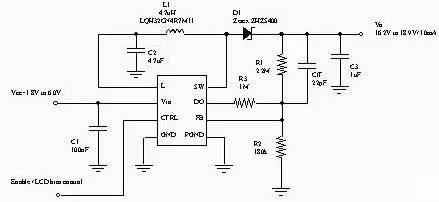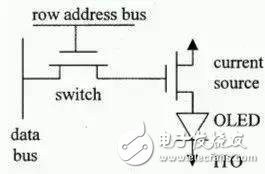Functionally advanced displays are becoming an important feature of today's consumer electronics products. The role of these new displays often reinforces the user's impression of the overall product, and such an impression ultimately determines how successful the product will be in the market. The impression of new displays is especially important when users are faced with mobile phones and pocket computers, as high-resolution color screens have become a must-have feature for these products.
A variety of new display technologies are expanding their market share, including new OLED displays, with ultra-high contrast values, fast response times and a wide viewing angle. Like other new technologies, vendors are using different LED materials (polymer or small molecule), active or passive matrix control, current and voltage drive technology, and different bias supply circuits to evaluate and manufacture different solutions.
This article will discuss various OLED technologies and appropriate bias supply circuits, and the choice of OLED technology and drive methods will also affect the power supply circuit requirements. The challenge for engineers is how to choose the most appropriate power supply circuit to support battery-powered portable devices, as well as the needs of specific OLED displays.
Passive matrix displays require a set of power boost convertersMatrix OLED screens are the mainstream of the current market, mainly used for mobile phones, most of which are external screens for shell-type mobile phones. These monochromatic or two-color passive matrix displays are ideal for OLED technology that is still in its infancy. Figure 1 is a simplified schematic of such a display, which is addressed in a manner similar to a standard passive matrix liquid crystal display. The main difference is that the OLED is a current-driven device, so the driving circuit of the OLED display is different from the liquid crystal display.

Figure 1: Simple schematic of a passive matrix OLED display
A moving matrix OLED display requires a set of positive voltages as its power supply or bias. This set of positive voltages is very similar to the voltage used in liquid crystal displays. It must provide low power consumption and high efficiency, and the solution must be very compact. small. Depending on the size and resolution of the display, the OLED driver component requires a voltage between 15V and 20V, so an inductive boost converter is the ideal solution.
Electrical isolation between the input and output is another important requirement for OLED bias supply, which is important when selecting a power supply. The Schottky diode used in the standard boost converter provides a direct path from input to output that causes the output voltage to be approximately equal to the input voltage; however, if the application requires a power sequencing function to power up or shut down, or a shutdown mode This path is the source of the problem by minimizing leakage current. The component shown in Figure 2 uses a built-in MOSFET switch to disconnect the input and output.

Figure 2: Boost converter isolates the input and output of an OLED display
Active matrix display requires positive and negative bias power supplyIf the application requires higher resolution, larger display area, higher contrast, and faster response time, they can use the active matrix OLED display shown in Figure 3.

Figure 3: Simple schematic of an active matrix display
The turn-on and address of the OLED pixel is controlled by an active switch, which is made up of a thin film transistor. It is manufactured in exactly the same way as a TFT liquid crystal display: the current source has been simplified to require only one MOSFET in series with the OLED. Some designs use a voltage-driven architecture, while others use a current-driven architecture. All designs require two to four or even more integrated thin-film transistors.
? To overcome the different aging speed problems of different color OLED pixels, some solutions integrate a photo transistor in the circuit to set a larger OLED current to avoid the pixel brightness decreasing with time. Low-temperature polysilicon (LTPS) substrates have a small component structure, so it would be an advantage if engineers wanted to make more active components on the substrate. At present, there are two technologies used for such substrates, namely low temperature polysilicon and amorphous silicon.
In addition to providing positive and negative voltages as the power source for the video signal driver, the bias power supply circuit of the active OLED display must also provide a bias voltage to enable the row select thin film transistors to be turned on and off. Inductive boost converters are the most suitable solution due to the high voltage of the bias voltage. To minimize the size of the solution, the fully integrated boost converter shown in Figure 4 uses an inverter to provide a negative voltage in addition to providing a positive voltage.

Figure 4: Single component provides both positive and negative voltages
In order to minimize the leakage current in shutdown mode and provide power sequencing for positive voltages, the components in Figure 4 control another external MOSFET transistor (Q1) in a SOT-23 or smaller package. This component uses a Li-Ion battery as the input power supply (2.7V to 5.5V) and provides output voltages up to +15V and -15V, as well as an integrated 800mA/2A switching current limit function that allows output currents up to 200mA. .
In order to provide power to the OLED display, the output voltage must be small and the switching frequency must be fixed to minimize the distortion and cross-coupling effects of the OLED display. In this regard, the TPS6513x with a 1.38MHz fixed-frequency PWM mechanism is ideal for providing power to OLED displays. Although providing a high-accuracy regulated output is particularly important for voltage-driven liquid crystal displays over the load current range, it does not pose much of a problem for current-driven OLED displays.
Some monitors require large currents when used outdoors, currents are reduced indoors, and they must provide high power efficiency over a wide range of load currents. Since the standard boost converter can only achieve optimum efficiency at the target load current, the TPS65130 additionally provides a user-selectable "power saving mode" that reduces the switching frequency and quiescent current, allowing the component to be High operating efficiency is maintained over the load current range.
As OLED technology matures, its market share will continue to rise. The potential of this technology in mobile phones, digital cameras and pocket computer screens is amazing. Active matrix displays may replace passive matrix displays in the market, OLED display driver components will become more advanced, and OLED bias power supply circuits will begin to be miniaturized and specialized, which is part of the solution described in this article. Have been discussed. For power supply component technology, the main challenge is how to provide high efficiency and minimum volume solutions at the same time.
The Beater Wheel is cantilevered. This unilaterally open construction offers the advantage that all mill parts that are subject to wear are easily accessible and can be replaced within a short period of time. The bearings have to meet stringent requirements. The MB series percussion wheel produced by our company has the characteristics of reliable operation, low price and long service life.
Beater Wheel Part,Cast Iron Flat Plate,Casting Strike Plate,Cast Tooling Plate
Shenyang Zhicheng Heavy Machinery Manufacturing Co., Ltd. , https://www.zhichengmachinery.com